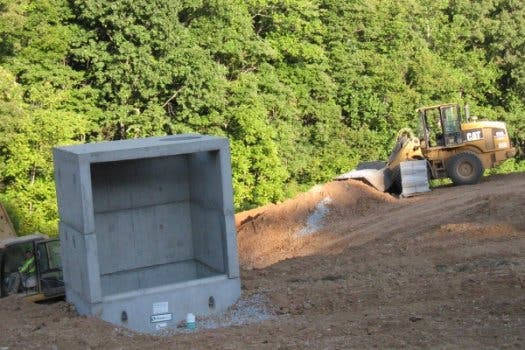While it may lack most of Bruce Wayne’s gadgets, the very first artificial bat cave in the world is sure to provide resonable accomodations for non-superhero dwellers. The cave was introduced after a group of environmentalists raised money, in an effort to help save thousands of bats from a disease which has claimed the lives of millions of bats so far in North America.
The cave, located in Tennessee where the most documented bat caves in the US can be found, has yet to receive a name and was built as a sanitary hibernaculum, in an attempt to dwindle the numbers of fallen bats which succumb to white nose syndrome, a condition named for the distinctive fungal growth around the wings and muzzles of hibernating bats that was first discovered in a New York cave six years ago. Since then around 6.7 million bats have perished to the disease.

Back to the bat cave. It’s located near the Tennessee town of Clarksville, and is 78 feet long and 16 feet wide or about the size of a single-wide mobile home. That might sound small, but officials from The Nature Conservancy which built and raised $300,000 for the cave, claim that it can house a minimum of 160,000 of the estimated 265,000 that reside in the nearby Bellamy Cave network, where the syndrome was first discovered back in March.
Cory Holliday, director of the Cave & Karst Program for The Nature Conservancy in Tennessee, says the cave is completely bat friendly. All sorts of improvised metal works hanging from the cave ceiling ensure that bats can cling onto them for slumber, a rainwater pipe ensures humidity levels are close to their natural habitat as well as provide drinking water. Also, currently two 1.5-ton air conditioning units will run for the next few weeks to drop the cave’s temperature to the required range, between 41 and 50°F. For the sake of science, cameras have been installed to monitor the bat population which is expected to migrate there for winter.
Why go to all this trouble and build an artificial cave when you could simply cleanse the existing infected caves? Well, things is, according to Sally Palmer, director of science for the Tennesee Conservancy, chemical cleansing of the caves would also kill beneficial fungi. This would debalance the ecosystem and bring a lot more harm than good.
How will the bats know to come here in the first place? Well, the staff installed ultrasonic speakers which are designed to play bat calls around winter migration time, in a move to entice them. If the project works, this could provide a model for a continent wide conservation effort. There are regions in North America where as much as 90% of the bat population was killed by fungi infections.
Source: Popular Science


